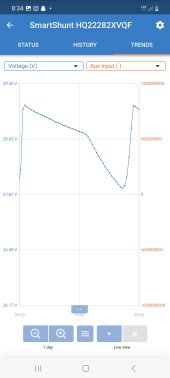harrisoncabintech
New Member
Hello everybody,
This is my first time posting so please bear with me as I am new to the solar world. I installed a system at my off grid cabin, I have 1000w of renogy solar panels that go to a 60A renogy charge controller. The charge controller feeds 3 100ah Deespeak 24v lifepo batteries (all in parallel) that power a 4000w sun gold inverter charger. It's been running now for the last 2 months and I finally had to to review my findings that were tracked by my victron smart shunt. I am finding that while I am away I've noticed this pattern of the batteries getting up to there 29.2v max charge (yes seems high but battery manufacture said that's what it should be) and then drops down to exactly 27.9v for half a day then goes back up. I have attached a picture of the smart shunt reading. This occurs constantly while I am not using the system. Is this normal or is there so.ething going arry here that I might be missing. All batteries were top balanced before install. Any help would be great.
This is my first time posting so please bear with me as I am new to the solar world. I installed a system at my off grid cabin, I have 1000w of renogy solar panels that go to a 60A renogy charge controller. The charge controller feeds 3 100ah Deespeak 24v lifepo batteries (all in parallel) that power a 4000w sun gold inverter charger. It's been running now for the last 2 months and I finally had to to review my findings that were tracked by my victron smart shunt. I am finding that while I am away I've noticed this pattern of the batteries getting up to there 29.2v max charge (yes seems high but battery manufacture said that's what it should be) and then drops down to exactly 27.9v for half a day then goes back up. I have attached a picture of the smart shunt reading. This occurs constantly while I am not using the system. Is this normal or is there so.ething going arry here that I might be missing. All batteries were top balanced before install. Any help would be great.



